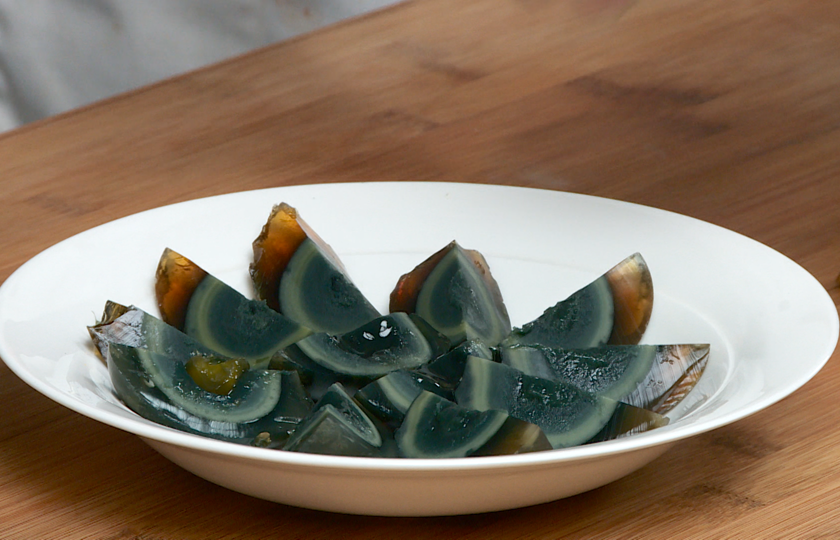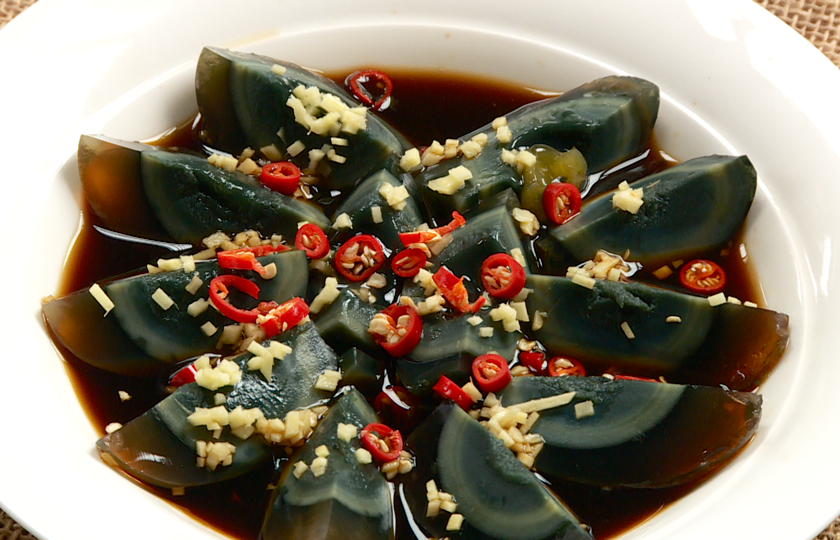Chinese Century Egg Salad (Pidan Salad)


During a family gathering, an elder made a cold dish with century eggs, and the unique texture immediately captivated me. The silky century eggs paired with a fragrant sauce melted in my mouth. Since then, I’ve fallen in love with this dish. Today, I want to share the recipe for cold century eggs with you all.
Introduction
Cold century eggs are characterized by their unique texture and rich flavors, making them particularly popular in the Jiangnan region of China. It is said that this dish was originally created to use up leftover century eggs. Over time, cold century eggs have become a beloved appetizer, commonly found not only on family dining tables but also at various banquets.
There’s an interesting legend about cold century eggs. According to the tale, an ancient chef, while preparing for a banquet, discovered leftover century eggs and wasn’t sure how to use them. Suddenly inspired, he sliced the eggs and added some seasonings and vegetables. To his surprise, this improvised dish became a huge hit. Since then, cold century eggs have been passed down through generations, becoming a classic appetizer.

Ingredients Needed and Substitutions
To make cold century eggs, you'll need the following ingredients:
Main Ingredients:
Century Eggs: The star of the dish, providing a unique texture and flavor.
Seasonings:
Ginger: Adds a refreshing aroma and taste, helping to reduce any fishiness from the century eggs.
Chinkiang Vinegar, Light Soy Sauce, White Sugar: These balance the flavors with acidity, saltiness, and a refreshing touch.
Substitutes:
Century Eggs: Can be replaced with regular eggs or tofu.
Ginger: If you’re not a fan, you can omit it or use other spices like minced garlic instead.
Chinkiang Vinegar: Can be substituted with rice vinegar or apple cider vinegar.
Light Soy Sauce: You can use regular soy sauce or soy paste.
White Sugar: Can be replaced with honey, brown sugar, or other sweeteners.
What is a Chinese century egg?
Century eggs, also known as preserved eggs or hundred-year eggs, are a traditional Chinese egg product made primarily from duck or chicken eggs using a special curing process.
During the curing process, materials such as lime, sodium carbonate, and salt are used. After a period of time, the egg whites and yolks undergo remarkable transformations. The whites turn a deep brown color with a smooth, gelatinous texture, and some century eggs even develop beautiful patterns resembling "pine flowers," which is how they got the name "松花蛋" (pine flower eggs). The yolk changes from its original bright yellow to a dark green color, offering a rich, alkaline flavor along with a unique egg aroma.
Are Chinese century eggs healthy?
From a nutritional standpoint, century eggs are rich in protein, making them a beneficial source of nutrients. However, they do contain some alkaline components, which may irritate the stomach if consumed in excess, particularly for those with sensitive digestive systems.
During the production process, materials like lime and sodium carbonate are used, which can lead to trace amounts of lead in the eggs. Fortunately, most commercially produced century eggs are now lead-free, as the manufacturing methods have been improved to ensure that lead levels meet safety standards, so there’s no need to worry excessively.
As long as they are eaten in moderation and purchased from reputable sources, century eggs can be a delicious and nutritious addition to your diet. They can definitely make a flavorful and healthy dish for your table!
Tips for Success
Choosing Quality Century Eggs: Select fresh, odorless century eggs with intact shells for the best texture in your cold dish.
Proper Shelling: Soak the century eggs in hot water for a few minutes to help separate the shell from the egg white, making peeling easier and preventing breakage.
Cutting with Precision: After peeling, cut the century eggs into quarters or sixths to showcase their beautiful patterns, enhancing visual appeal and appetite.
Balancing Flavors: Be mindful of the seasoning; the ratio of vinegar to soy sauce should be just right to avoid an overly sour or salty dish.
Tip: For extra flavor, marinate the century eggs with the seasonings for a while before serving. Using fresh minced garlic and ginger can also elevate the aroma of the cold century eggs.
INGREDIENTS
Main Ingredients
-
·3 Century Eggs
Additional Ingredients
-
·10g Ginger
Seasonings
-
·30ml Chinkiang Vinegar
-
·15ml Light Soy Sauce
-
·5g White Sugar
COOKING STEP
Step 1
Gently tap the century eggs to crack the shells, then peel them and cut each egg into quarters. Arrange the pieces neatly on a plate.

Step 2
Wash the ginger and finely mince it.

Step 3
In a clean bowl, combine the Chinkiang vinegar, light soy sauce, and white sugar. Mix well with chopsticks to create the sauce.

Step 4
Slowly drizzle the sauce over the arranged century egg pieces.
Evenly sprinkle the minced ginger over the century eggs.

Step 5
Place the dish in the refrigerator to chill for ten minutes before serving. Enjoy!

Recipe Variations
Innovative Ingredients and Seasonings:
Honey: Adding a bit of honey to the traditional seasonings can enhance the flavor of the century eggs, creating a delightful balance of sweet and salty.
Lemon Juice and Thai Chilies: Incorporating lemon juice and Thai chilies will intensify the sour and spicy notes, perfect for those who enjoy bold flavors.
Thai Fish Sauce and Lemongrass: Mixing in some Thai fish sauce and lemongrass gives the century eggs a Southeast Asian twist, appealing to adventurous eaters.
Vegetables: To make it a healthier light dish, reduce the amount of seasonings and add more vegetables, such as shredded cucumber or carrots.
Sesame Seeds and Cilantro: Finally, sprinkle sesame seeds and cilantro on top for added aroma and texture.
Detailed Steps for the Innovative Preparation:
Prepare the Ingredients: Peel the century eggs and cut them into quarters, arranging them neatly on a plate.
Make the Sauce: In a small bowl, combine minced garlic, light soy sauce, aromatic vinegar, chili oil, and white sugar. Mix well to create the sauce.
Adjust the Ingredients: Modify the sauce ingredients based on your chosen innovative approach.
Drizzle the Sauce: Evenly drizzle the sauce over the century egg pieces.
Garnish: Finally, sprinkle cilantro and sesame seeds on top for an aromatic and textured finish.

Serving Suggestions
Recommended Pairings:
White Rice: The sauce from the cold century eggs is perfect drizzled over white rice, creating a simple yet delicious combination.
Light Vegetables: Pair with light dishes like cucumber salad or stir-fried seasonal vegetables to balance the rich flavors of the century eggs.
Congee: Enjoying cold century eggs with century egg and pork congee or plain congee can enhance the flavor complexity, making for a hearty breakfast or dinner.
Noodles: They pair well with various noodles, especially cold noodles or mixed noodles, adding a spicy kick that’s perfect for summer.
Soups: After having cold century eggs, a bowl of light tomato egg soup or seaweed soup can balance the flavors and provide a refreshing taste.
Consumption Suggestions:
Moderation: Due to the presence of trace amounts of lead and other heavy metals, it's advisable to consume century eggs in moderation.
Special Considerations: Pregnant women, children, and those sensitive to lead should avoid consumption or do so under medical guidance.
Chill Before Serving: Cold century eggs have an even better texture when refrigerated, especially on hot summer days, providing a refreshing coolness.
Varied Pairings: Feel free to adjust the seasoning ratios to your liking, or try adding new ingredients like nuts or sesame seeds for extra nutrition and texture.
FAQs:
My Recommendation:
For a Raw Texture: Simply peel and slice the eggs, then mix them with your favorite sauce. This method preserves the egg's original flavor.
For Safety or Preference: If you’re concerned about food safety or don’t enjoy the raw flavor, you can boil the eggs in hot water for 2-3 minutes, then cool them rapidly before peeling and slicing. This will make the texture firmer and reduce any off-flavors.
Tip:
When boiling century eggs, adding a pinch of salt can enhance the flavor and help minimize any undesirable taste. After boiling, soak the eggs in cold water for easier peeling without breaking.
In Chinese culinary culture, century eggs hold a special place as a traditional delicacy. The curing method imparts a distinct flavor that sets them apart from regular eggs. The rich, alkaline aroma and unique fermented taste of century eggs are absent in chicken eggs. Even century eggs made from chicken eggs undergo significant flavor changes during the curing process.
You can also make century egg and lean meat congee. Cook rice until it becomes porridge, then add diced century eggs and marinated lean meat, cooking until thickened. This comforting dish is perfect for breakfast or when you're not very hungry, featuring the unique flavor of century eggs alongside the savory meat.
Additionally, century eggs can be used in soup. Cut them into small pieces and cook them with ham, mushrooms, and other ingredients. The soup will have a rich flavor from the century eggs, making it delicious and great for serving over rice.
If you enjoy spicy flavors, try making smashed green peppers with century eggs. First, pan-fry the green peppers until blistered, then mash them with the century eggs and seasonings for a dish that combines the pepper’s heat with the egg's aroma.
This black color is a natural phenomenon resulting from the curing process and contributes to the unique flavor and texture of century eggs. Their distinct alkaline taste and color change are key characteristics that differentiate them from fresh eggs.
Not Flavorful Enough: If the salad lacks intensity, it may be due to insufficient seasoning or not mixing well. Adjust the seasoning to your taste and ensure that the sauce thoroughly coats each piece of egg.

















